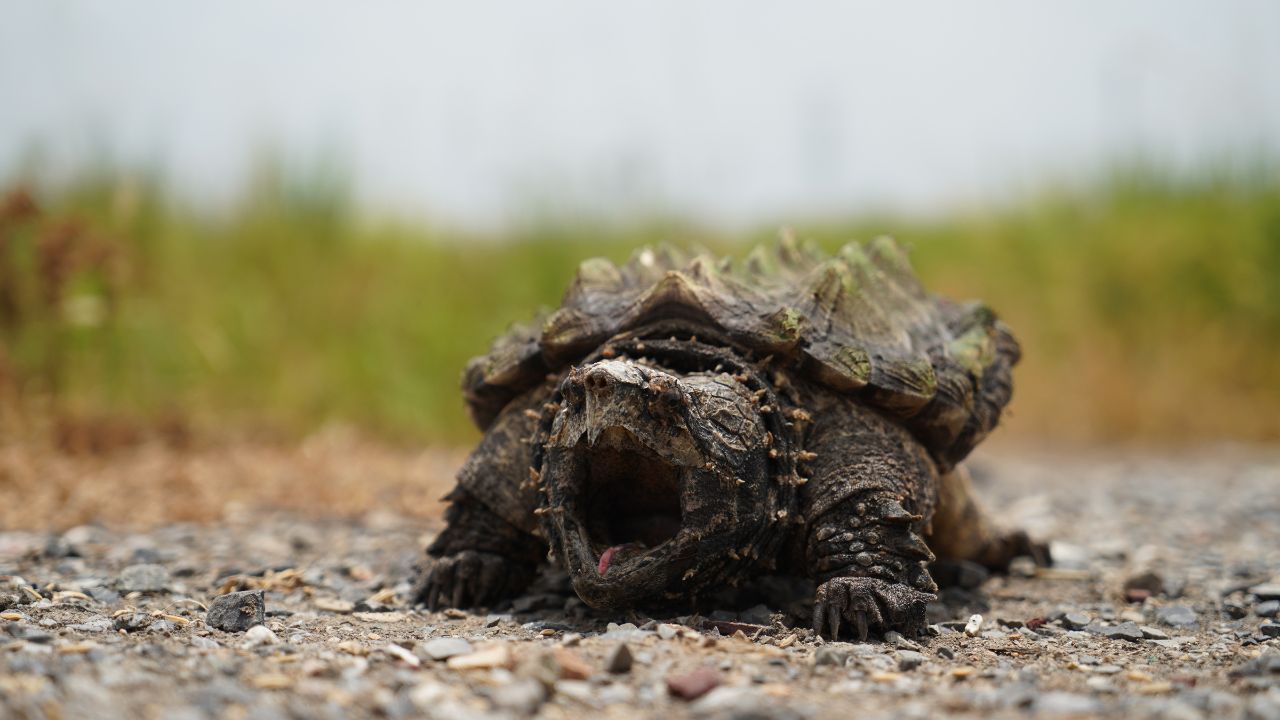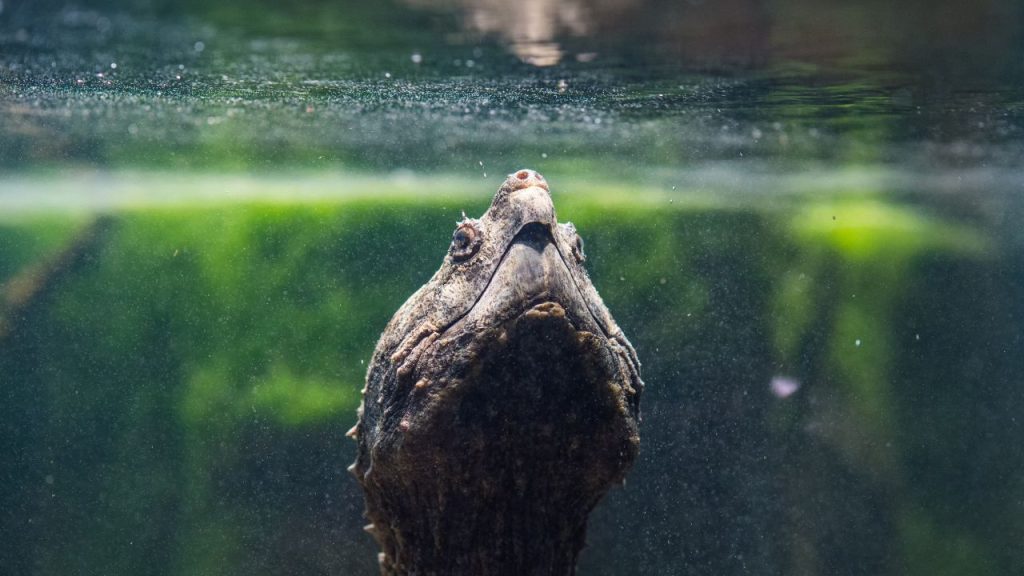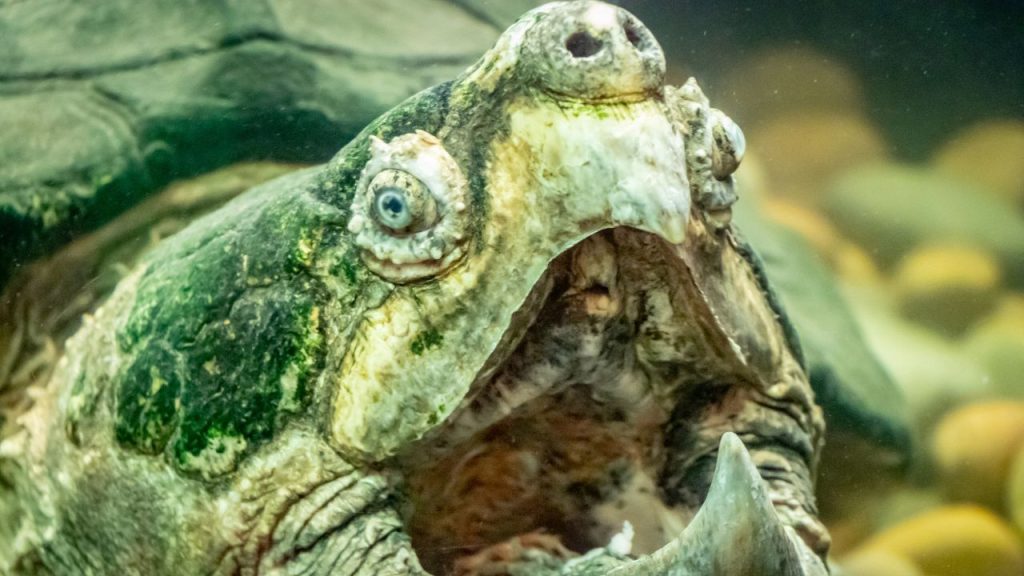How To Take Care Of An Alligator Snapping Turtle? [Foolproof Guide]


fact checked & review by
Dr. Partho Kumar Shaha
Veterinarian (DVM)
The information is current and up-to-date in accordance with the latest veterinarian research.
A heartiest congratulations to you if you have got yourself an alligator snapping turtle. Not everyone has the courage and experience to take this turtle in. But before adopting or buying this turtle, learn to take care of this subspecies first.
You can divide the alligator snapping turtle care sheet into 4 categories,
- Habitat Setup: Spacious tank, basking dock, lighting, filter, tank heater, etc.
- Diet: Shrimp, frogs, insects, vegetables, fruits, pellets, supplements, etc.
- Take precautions in breeding and hatching the clutch.
- Health checks up regularly.
Access a detailed care sheet for the alligator snapping turtles from below.
Alligator Snapping Turtle: Species Summary
| Scientific Name | Macrochelys temminckii |
| Common Name | Alligator snapping turtle, alligator snapper |
| Family | Chelydridae |
| Origine | North America |
| Natural Habitat | Freshwater sources, rivers, lakes, streams, etc. |
| Size | Up to 32 inches |
| Weight | Up to 15o pounds |
| Lifespan | Up to 120 years |
| Food Habit | Omnivorous |
| Avengere Cost | $30 – $40 |
| Care Level | Expert |
How To Take Care Of An Alligator Snapping Turtle?
Before getting into the main care sheet, let me share a detailed profile of an alligator snapping turtle. This will help you know this turtle even better.
Appearance: How Do Alligator Snapping Turtles Look?
You would recognize an alligator snapping turtle immediately after seeing one. The beast-looking appearance of this subspecies is hard to avoid.
The first thing you will notice in an alligator snapping turtle is the large, triangular head. Their eyes are set on the sides of this pointy head. Also, the strong jaw and hooked beak of this subspecies are hard to ignore.
Shells of the alligator snapping turtles can be brown to dark brown or dark green to olive. The carapace of these turtles is extremely rough, and the scutes are in the form of ridges. On the contrary, the plastron is small and cross-shaped.
Small spiked-like scales run all over the body of alligator snapping turtles. Apparently, this roughness protects these creatures from getting scratched. Moreover, alligator snapping turtles have wrinkled skin full of bumps.
Furthermore, alligator snapping turtles have thick and long tails. You can also identify these subspecies with their thick, worm-like red tongue. These turtles use their tongue to lure fish and other prey.
Native Habitat: Where Do Alligator Snapping Turtles Live?
The United States is the native habitat of alligator snapping turtles. This subspecies ranges in the southeast USA, from Florida to Texas.
Alligator snapping turtles are also spotted in the north of Illinois. Iowa and Georgia are also native habitats of some alligator snapping turtles.
The alligator snapping turtles are found in the streams of the Gulf coast of Mexico, the Mississippi River, the Suwannee river, etc.
Alligator snapping turtles are basically freshwater turtles. They live in streams, rivers, lakes, blackwater swamps, and sometimes in brackish water sources.
Size: How Big Do Alligator Snapping Turtles Get?
Alligator snapping turtles are definitely bigger than common snapping turtles. While common snapping turtles can grow up to 22 inches at best, alligator snapping turtles can reach up to 32 inches in carapace length.
But, of course, not all alligator snapping turtles experience the same growth. The average carapace length of this subspecies lies within 15 – 26 inches. However, the biggest alligator snapping turtle ever captured is 31.8 inches.
The alligator snapping turtle hatchlings are born 1.5 inches and weigh roughly a few ounces. Soon the creatures go through a 2X growth and reach 8 – 10 inches of carapace size within 5 years.
When adults, the alligator snapping turtles weigh more than 175 pounds. According to available data, this subspecies can reach 250 pounds and even more.
Here I am adding a growth chart for the alligator snapping turtle,
| Age | Carapace Length | Weight |
|---|---|---|
| Hatchlings | 1.5 inches | few ounces |
| 1 year | 2.5 to 4 inches | 1 to 2 pounds |
| 2 years | 5 to 6 inches | — |
| 3 years | 6 to 8 inches | — |
| 5 years old | 8 to 10 inches | — |
| 10 years old | 10 to 12 inches | 10 to 35 pounds |
| 15 to 20 years old | 12 to 16 inches | 35 pounds++ |
| 40 years old | 16 to 26 inches++ | 46 pounds (female) |
| 50 years old | 16 to 26 inches++ | 64 pounds |
| 80 years old | 16 to 26 inches++ | 100 pounds |
| 100 years old | 16 to 26 inches++ | 125 to 175 pounds (male) |
N.B. An alligator snapping turtle may have a growth different from this chart. But it is fine as long as the pet is active and eats properly. However, you can consult a vet to avoid risks. Moreover, go through this article to find out the factors that affect the growth of alligator snapping turtles.

Lifespan: How Long Do Alligator Snapping Turtles Live?
Alligator snapping turtles are blessed with a long lifespan. In fact, in many cases, the pets outlive their owners.
As per available information, the average longevity of alligator snapping turtles is 70 years. But most of these creatures have a life expectancy of 80 – 120 years.
In 2012, a group of researchers captured a wild alligator snapping turtle. According to their estimation, the approximate age of that turtle is nearly 80.
Reports say that the oldest living alligator snapping turtle was 150 years. But unfortunately, she passed away in 2016.
Do you know you can influence the lifespan of your alligator snapping turtle? Check this article to find the tricks.
Behavior: Are Alligator Snapping Turtles Aggressive?
Is an alligator snapping turtle aggressive? You bet it is.
Alligator snapping turtles are more aggressive than any other turtle species you know. Not only that. These creatures do not think twice before attacking you.
Unfortunately, the bite of an alligator snapping turtle is terrible. The hooked beak can pierce through your skin. There are even reports of alligator snapping turtles biting off human fingers. The intensity of the bite depends on the size of the turtle.
But do not take the alligator snapping turtles as ferocious creatures. They are actually shy and only act hostile when they feel threatened.
Yes, the alligator snapping turtles have bulky bodies and razor-like beaks for self-defense. Yet, the animals are vulnerable because of their neck. Apparently, these turtles can not retract their whole bodies in the shell, and their neck just rests at the side. Therefore, they always stay alert and consider any susceptible movement a threat.
So, behave gently with the alligator snapping turtles. Do not touch them frequently, and handle them with care.
Tank Size: What Size Tank Do Alligator Snapping Turtles Need?
The first challenge of raising a pet alligator snapping turtle is to manage space. As this subspecies grows up to 32 inches, they require huge habitats to thrive.
Though you can keep the baby and young alligator snapping turtles in small tanks, you must switch to a spacious one when they grow bigger. For example, a 55-gallon tank works for a 6 – 8 inches alligator snapping turtle.
The turtles will require an aquarium of 125 gallons or more when they hit 12 inches or more. After that, you may have to upgrade to a 200-gallon to 800-gallon tank as the creatures grow bigger.
Basking Dock: Do Alligator Snapping Turtles Bask?
Alligator snapping turtles are aquatic species and spend most of their time underwater. However, they have to come to the land for bask. Though you will barely spot the alligator snapping turtles basking, it is not something you should ignore.
You can set up a basking station for the pets in an indoor habitat. Of course, a commercial dock with a proper ramp is always recommended. Nevertheless, you can build a platform by utilizing logs, rock, metal sheets, plastics, foams, or any smooth-edged material.
While selecting the basking dock, ensure it can hold the weight of the alligator snapping turtles. Then, again, you need to provide the turtles with a proper ramp to get on the platform. This article lists the best commercial docks available for alligator snapping turtles.
Yes, I know, snapping turtles are the masters of jumping among all species. But considering the distance the turtles cover, you will barely call it a jump.
Moreover, the alligator snapping turtles also need a basking spot in an outdoor enclosure. Hence, you can place big logs and smooth rocks around the pond for this purpose.
In short, whether the snapping turtle is in an indoor or an outdoor habitat, it requires basking and a basking dock. Without the station, the pet may stay underwater for longer hours, leading to infectious and cold diseases.

Heating Lamp: Do Alligator Snapping Turtles Need Heating Lamps?
Heating is mandatory for any turtle species. It is because turtles are cold-blooded creatures and solely depend on external heat to function properly.
The turtles will slow their metabolism and activity if you remove the heat. As a result, they will start saving energy by dropping the heartbeat and oxygen consumption rates. Such a state is called hibernation.
Though hibernation is natural and common in the wild, we do not want to hibernate captive turtles. Hibernating the pet requires following a strict routine and preparing the turtle for the process. Without the preparation, the turtle’s body may be unable to pull off the stress of hibernation and get sick.
To be safe, installing a heating lamp is always recommended. Our regular watt bulbs may radiate heat, but they are not suitable for snapping turtles. So, set up proper heating lights for these reptiles. Get the best deals on alligator snapping turtle heating lamps from this link.
While setting up the heating lamps, maintain a fixed distance between the basking dock and the light. Also, ensure the bulb creates a gradient of heating zones in the enclosure. This way, the turtle can move from a hot zone to a cool area as needed.
You have to keep the lights on 10 – 12 hours a day. The suitable air temperature for this subspecies is 80 – 86 degrees Fahrenheit. On the other hand, the basking temperature should be in the range of 90 degrees Fahrenheit.
You don’t need a heating lamp to raise an alligator snapping turtle in an outdoor pen. The sun will provide the heat. But in winter, when the sun is not up for days, you have to move the pet to an indoor setup.
UV Light: Do Alligator Snapping Turtles Need UV Lamp?
UV lamps are another necessity for snapping turtles. The UVA and UVB rays do wonders to keep these creatures healthy and fit.
For example, the UVA exposures help the alligator snapping turtles to stay mentally chill and stable. Also, these rays are important to keep pets active.
Again, the UVB rays are crucial for solid bone and shell growth for alligator snapping turtles. In addition, the exposures influence vitamin D3 production in the turtles and, later, promote calcium absorption. As a result, the turtles get a healthy skeleton.
So what happens if there is no UV lamp in the enclosure? Well, it will cause soft shells in the creatures. Not to mention the other conditions that will arise due to the lack of UVB rays. For example, bumpy shells, bad digestion, weak immunity, etc.
As per many reports, the absence of UV lamps can cause death in baby alligator snapping turtles. So, set up a quality UV light in the indoor enclosure.
While shopping for a UV lamp, consider its UV percentage. A 2.5% – 3% UV light is suitable for aquatic turtles. Though you can go for a 5% UV, a 10% UV lamp is a no for the alligator snapping turtles. I have listed the best UV lamps available in the market here.
Moreover, like the heating lamp, you have to install the UV lights to maintain a fixed distance. Generally, a 12 – 18 inches distance from the basking dock is suggested.
Furthermore, keep the UV lamp on 12 – 14 hours a day and replace the UV light every 6 months.
Remember, a UV bulb is mandatory for indoor alligator snapping turtles. But there is no need for an artificial UV light for outdoor pets. The sun is the natural source of UV rays outside.
Water Filter: Do Snapping Turtles Need Water Filters?
Alligator snapping turtles are freshwater turtles, which means they can not stand dirty water conditions. A filthy environment can entice bacterial and fungal growth in the pen, leading to infectious diseases.
While in the wild, mother nature takes care of the cleaning of the rivers and streams. However, when in captivity, you are in charge.
Changing the tank water every day is not feasible to maintain cleanliness. It can not only make the aquarium water cloudy, but it also kills good bacteria. Learn how to fix cloudy turtle tanks from here.
So, installing a water filter is the best way to maintain cleanliness inside an alligator snapping turtle’s pen. The devices suck the dirty water, filter the filth and recirculate fresh water suitable for the turtles. But, most importantly, the filter does not kill friendly bacteria.
The filter size solely depends on the size of the tank. Going for a powerful water filter is always better. I have been using canister filters for my turtle tanks for years. Catch my top picks with an honest review from this write-up.
After installing a water filter, your manual labor for cleaning the tank significantly reduces. Now you just have to replace 25% of the water only once a week and clean the whole filter once a month.
A water filter is necessary for both indoor and outdoor pens. Do not set up the small canister filters in your outdoor habitat. The ponds and pools require more powerful filters for proper cleaning.
Water Heater: Do Alligator Snapping Turtles Need A Water Heater?
I have already mentioned the necessity of heat for the alligator snapping turtles. While the basking lamps keep the air and land warm, the water is still cold. And yes, alligator snapping turtles spend most of their time in the water.
So, what can you do?
Well, some people may suggest you mix hot water in the tank to keep the alligator snapping turtles warm. But those acts are dangerous and can hurt pets.
The best way to heat the aquarium temperature is to install a tank heater. Digital heaters track the temperature of the water and regulate it as per the turtle’s requirement.
The suitable temperature range for alligator snapping turtles is 75 to 85 degrees Fahrenheit. Any deviation from this range can cause the pets discomfort. So again, when selecting the heater, make sure it can process the tank capacity.
You can go for a single or multiple heaters set up according to the habitat size. Go and check out my budget tank heater list from this article.
Of course, you can not keep the outdoor pens warm with tank heaters. Thus, you have to bring the pets inside when the temperature is close to zero.
Substrate And Decoration
A tank with a bare bottom is perfect for the alligator snapping turtles. Putting a substrate will only make the water fizzy and cloudy.
Not only that. Substrates can trap food scraps, poop, and other filths, which cause infectious diseases later. Moreover, cleaning the substrate is always challenging.
But sometimes, you have to lay up the tank bottom with the substrate to add plants. In that case, use mixed soil for better results.
Gravels are also a good option. Also, the colorful, medium-sized gravels give the tank a pleasing look. However, when building an outdoor enclosure for the alligator snapping turtles, you have to focus on the natural substrates.
When it comes to live plants, those are not mandatory. But yes, adding live plants to the enclosure makes the terrarium more aesthetic and increases the oxygen level. Moreover, the broad leaves act as hiding spots for the turtles. Follow my previous write-up to find out the safe plant list for alligator snapping turtles.

Diet: What Do Alligator Snapping Turtles Eat?
Alligator snapping turtles mainly eat animal protein. Yet, they are considered omnivorous due to the little amount of vegetables in the meals.
The diet chart of the alligator snapping turtles basically includes 5 types of food,
1. Animal Protein:
An alligator snapping turtle’s meals should contain at least 70 – 75% animal protein. Feeder fish, crayfish, guppies, snails, shrimps, shredded turkey meat, chopped chicken, raw beef, liver, frog, minnows, tadpoles, small reptiles, cockroaches, mice, bloodworms, mealworms, earthworms, insects, geese, etc., are safe protein options for alligator snapping turtles.
2. Plant Matter:
Alligator snapping turtles are not big fans of plant matter. But you have to add vegetables to the meals to balance the diet. Experts suggest feeding the pets 25 – 30% greens every day.
The safe vegetables for the alligator snapping turtles are,
- Corn
- Romaine lettuce
- Tomatoes
- Spinach
- Asparagus
- Collard greens
- Green beets
- Green leafy vegetables
- Red leaf salads
- Peppers
- Kale
- Pumpkin
- Mustard green
- Cauliflower
- Parsley
- Brussel sprouts
- Chinese cabbage
- Carrots
- Dandelion green
- Broccoli
- Green beans
- Turnip greens
- Sweet potato
- Squash
- Water hyacinths
- Waterweed
- Duckweed
- Dill weed
- Algae
- Hornwort
- Java moss, etc.
3. Fruits:
Fruits are high in natural sugar, and sugary items do not suit the alligator snapping turtles. But feeding the pets fruits occasionally can boost their appetite. You can feed them strawberries, blueberries, melon, apples, bananas, kiwi, guava, pomegranate, raspberry, coconut, resin, lime, etc.
Remember, too much fruit can upset the stomach of these turtles.
4. Commercial Items:
Though commercial foods are not always suggested for the alligator snapping turtles, one item or two might not harm them. You can feed the turtles commercial pellets, dried worms, dried shrimp, etc. However, 20 – 30% of pellets are safe for turtles. But exceeding this limit can harm them.
5. Supplements:
A balanced diet is not always enough to fulfill the mineral requirements of the alligator snapping turtles. Thus, you have to add mineral and vitamin supplements to the turtle’s diet. Multivitamin once a week and calcium thrice a week is the ideal way of feeding the turtles supplements.
Do you know how to feed calcium to turtles? Find out the tricks from my previous article.
Foods To Avoid:
You can not just feed the alligator snapping turtles anything. Providing the wrong diet will make the pets vomit and cause diarrhea. Here are the items you should avoid in the turtle’s meals,
- Cucumber
- Iceberg lettuce
- Mushroom
- Dog food
- Processed food
- Salami
- Sausage
- Bread
- Cheese
- Bacon, etc.
Click here for a detailed snapping turtle diet.
How Much To Feed An Alligator Snapping Turtle?
Measuring the food quantity is important to keep the alligator snapping turtles fit and healthy. I follow two techniques to determine the meal quantity, such as,
1. The 15-minute Rule
- Mix the food items and make a balanced meal.
- Leave the meal inside the alligator snapping turtle’s enclosure.
- Let the pet eat for only 15 minutes.
- Remove the leftovers.
2. The Head Method
- Take a bowl about the size of the alligator snapping turtle’s head if it were empty.
- Fill it with all food items.
- Feed the turtle.
How Often To Feed An Alligator Snapping Turtle?
The feeding routine for alligator snapping turtles varies depending on the age. Of course, baby snapping turtles require more nutrition and have the most appetite. Hence, you have to feed these hatchlings every day.
On the other hand, the juvenile alligator snapping turtles function just fine with a every other day diet routine. Moreover, adult turtles need a thrice-a-week meal schedule.
Potential Health Diseases Of Alligator Snapping Turtles
I know that alligator snapping turtles can stand in almost any harsh environment. But diseases make them vulnerable and lifeless. Hence, a primary treatment at the initial stage of any illness or the prevention of the sickness can offer the turtles a more comfortable life.
The common signs of diseases in alligator snapping turtles are, coughing, sneezing, wheezing, weight loss, appetite loss, runny nose, puffy eyes, infection, etc. Take the pet to a vet if you notice any abnormalities in the pet.
You will find a more specific treatment for different diseases below,
Hypovitaminosis A
Lack of vitamin A in the alligator snapping turtle’s diet can lead to hypovitaminosis A. This vitamin is crucial for keeping skin tissues in shape and building a strong immunity system. Hence, the deficiency makes the turtles suffer.
Swollen eyes, puffy eyes, tissue buildup on eyes, mouth rot, infectious diseases, appetite loss, etc., are common symptoms of hypovitaminosis A in alligator snapping turtles. Letting the turtles live with this sickness can worsen the condition. Therefore, you need to offer the pets immediate treatment.
Generally, hypovitaminosis occurs because of inappropriate meal choices. Thus, a balanced diet rich in vitamin A can cure this disease. Sometimes the vets can prescribe antibiotics and meds for fast recovery.
Respiratory Illness
Experts suggest that prolonged vitamin A deficiency leads to respiratory infection. Well, the lack of proper minerals can weaken the immune system, making the turtles vulnerable to any bacterial attack. Such an infectious condition of the lungs is called respiratory sickness.
Turtles with respiratory illness exhibit symptoms like sneezing, wheezing, coughing, lethargy, appetite loss, discharge from eyes, mouth, or nose, etc. However, wheezing sounds while sleeping may indicate snoring in alligator snapping turtles.
Respiratory illness is not something you should ignore. Instead, take immediate steps to treat your turtles. Otherwise, the pets will develop pneumonia. In worse conditions, the turtles can even die.
Home treatment is not enough for respiratory infection in alligator snapping turtles. Of course, you can follow a strict recovery routine along with the prescribed meds from the vet.
Keeping the turtles isolated in a warm enclosure is necessary for sick turtles. Also, make sure the humidity range in the pen is in the suitable range. Besides, feed the pets a balanced diet to keep them energetic and ready for the healing process.
Metabolic Bone Disease
Alligator snapping turtles can suffer from MBD or metabolic bone disease due to the lack of UV rays in the enclosure. However, this illness is rare in wild turtles as they can absorb UVB rays from the sun.
The absence of a quality UV bulb not only messes up the alligator snapping turtles’ mental stability and activity level. But it is also responsible for deforming the shells and bones. As a result, turtles with the MBD condition often have trouble walking.
Adding calcium and vitamin D3 supplements to meals is mandatory to cure this disease. Besides, you have to install a quality UV bulb in the enclosure for both recovery and prevention.
Shell Rot
Shell rot is very common in alligator turtles. The condition starts with a small scratch on the shell. Apparently, the narrow opening is enough for the bacteria or fungi to enter the scutes and grow the population. Soon, you will notice black spots around the wound as a sign of the shell rotting.
Other symptoms of this disease are, discharges from the shell, foul odor, lethargy, loss of appetite, etc. In worse conditions, bacteria can enter the bloodstream, infecting the mass and bones. As a consequence, the shell plates may fall off as a whole.
A guide for home treatment of shell rot is attached here.
You can home treat the pets if the shell rot is at the primary level. For example, keep the alligator snapping turtle isolated and away from water. However, the creature requires warmth and so, place it in a warm area.
Bath the turtle daily with antibacterial solutions followed by a healing cream. Sticking to this routine for a week can heal the turtle completely.
However, in severe cases, do not take any risk. Instead, the vet will keep the pet under observation and offer necessary medications.
Pyramiding
Overfeeding of protein can cause pyramiding in alligator snapping turtles. Bumpy scutes are the main sign of this condition. Controlling the diet can fix this illness in pets.
Parasite Attack
Alligator snapping turtles living in filthy environments can fall victim to parasite attacks. In this condition, the worms get into the intestine of the turtles and start living off them.
As a result, the pets lose weight significantly and show lethargic behavior. In some conditions, worms come off the system with poop or vomit.
Deworming the turtles annually is the only cure and prevention of these diseases. Besides, you should keep the environment clean and hygienic.
Organ Failure
Organ failures are more severe health conditions but are not rare. Unfortunately, there is no treatment for such diseases. However, maintaining proper medications can lessen the suffering of sick alligator turtles.
Again, certain conditions can lead to organ failures. For example, obesity, overfeeding protein, etc., cause kidney stones and liver failure. Hence, you should be more careful while feeding the pets.

Reproduction Care: How To Breed Alligator Snapping Turtles?
Breeding the alligator snapping turtles in captivity is not a wise decision. Mating can be stressful for any turtle, and any wrong step can cause permanent damage to them.
However, if you plan to breed the turtles, prepare them before the mating season. Usually, snapping turtles are mostly sexually active during the warmer months, from April to November.
Put the healthy adult male and female in a single enclosure with all facilities. Some breeders place multiple males and females to increase the success ratio.
Generally, the male alligator snapping turtles approach the females for mating. They will mount the females from behind and swim around them to show their interest. You have to separate the couples after successful copulation.
The gravid alligator snapping turtle will require special care. For example, the mother turtle will start looking for a suitable place to lay her eggs. You can attach a nesting box to the main terrarium.
The mother turtle deposits 20 – 40 creamy eggs in the nest. Then she covers the hole with dirt and leaves the place.
After a day or two, you must dig out the eggs and put them in the incubator. If you are a newbie, follow this guide for incubation details. The alligator snapping turtle’s eggs will hatch within the next 3 months.
How To Pick Up An Alligator Snapping Turtle?
You already know how aggressive an alligator snapping turtle can get. One wrong move while handling the pet, and you can lose your finger. Hence, you can not just pet the turtle without knowing the safety rules.
Here is the easiest way to pick up or handle an alligator snapping turtle,
- Approaching the turtle from behind is a wise decision. Going for the grab from the front can scare the turtle, and it may initiate an attack. Also, be silent with your steps.
- Now grab the turtle with both your hands, with each hand behind the rear legs.
- Gently pick the turtle up from the ground. But keep the body as low as possible and the head downward.
- Do not put your hand in front of the turtle purposefully. Alligator snapping turtles have flexible necks and can bite you even from a distance.
- You can pick up the baby and juvenile snapping turtles with one hand. But you may need help to handle the adult alligator snapping turtles. It is because adult alligator snapping turtles weigh more than 175 pounds.
This article has added a detailed guide on picking up alligator snapping turtles.
Price & Affordability: How Much Do Alligator Snapping Turtles Cost?
Alligator snapping turtles are a bit more expensive than common snapping turtles. The normal alligator snapping turtles are available at $30 – $40. However, you may have to pay several thousand dollars to get an exclusive one.
Here is a price chart for different snapping turtles,
| Snapping Turtle Subspecies/Breed | Price Range |
|---|---|
| Common Snapping Turtle | $30 to $170 |
| Alligator snapping Turtle | $40 to $150 |
| Albino Common Snapping Turtle | $4999.99 |
| Platinum Florida Snapping Turtle | $99 |
| Pink Belly Snapper | $79.95 |
| Orange Hypomelanistic Common Snapping Turtle | $495 |
| Hypo Melanistic Common Snapping Turtle | $495 |
| Translucent Hypomelanistic Common Snapping Turtle | $1495 |
| Leucistic Common Snapping Turte | $2495 |
| Two Headed Common Snapping Turtle | $5999 |
| Hypomelanistic Pink Alligator Snapping Turtle | $449.99 |
| Pied Alligator Snapping Turtle | $449.99 |
| Florida Snapping Turtle | $39.99 |
| Branderhorst’s Snapping Turtle | $74.99 |
| New Guinea Snapping Turtle | $49 |
| Schultze’s Snapping Turtle | $59.99 |
The cost of the alligator snapping turtles is not fixed and depends on the subspecies, health, age, size, etc. So here, I have put the chart only to give you an idea of the price range of these turtles.
Find out the nearest pet stores to buy alligator snapping turtles from this article.
Is Alligator Snapping Turtles Good As Pets?
Alligator snapping turtles are indeed not for beginners. In fact, experienced owners also have a hard time raising this subspecies. So, before adopting or getting this species, you need to study the care sheet thoroughly.
Alligator snapping turtles are generally shy. However, you will find this species in their good behavior as long as you do not stress them out. Moreover, the pets are low maintenance.
So, if you love challenges, alligator snapping turtles can add new adventures to your turtle-keeping journey.
Conclusion
Taking care of an alligator snapping turtle can be challenging at first. But not for long. In fact, you will start enjoying the journey once you get to know this turtle. However, in any case, read the care sheet multiple times before taking the species in or trying out anything new with them.

About Author
Muntaseer Rahman started keeping pet turtles back in 2013. He also owns the largest Turtle & Tortoise Facebook community in Bangladesh. These days he is mostly active on Facebook.
Disclaimer
This site is owned and operated by Muntaseer Rahman. TheTurtleHub.com is a participant in the Amazon Services LLC Associates Program, an affiliate advertising program designed to provide a means for sites to earn advertising fees by advertising and linking to Amazon.com. This site also participates in other affiliate programs and is compensated for referring traffic and business to these companies.

